Burberry Plc: Operations & Project Management - Report and Portfolio
VerifiedAdded on 2023/06/07
|15
|4774
|279
Report
AI Summary
This report provides a comprehensive analysis of operations and project management principles within Burberry Group plc, a leading luxury fashion brand. It differentiates between operations and operations management, reviews the implementation of operations management principles such as inventory management, cost reduction through lean production, resource optimization, agile manufacturing, and quality management. The report evaluates how well operations management meets organizational needs, discussing cost reduction, customer service, enhanced quality, and resource utilization. It debates continuous improvement as a philosophy, describing Lean principles and Six Sigma, and proposes a continuous improvement plan with recommendations justified by theories like the PDCA cycle. The project portfolio section elucidates each stage of the project lifecycle, evaluates project methodologies and tools, and critically analyzes the effectiveness of the PLC through suitable theories. Desklib offers a range of study tools and solved assignments for students.
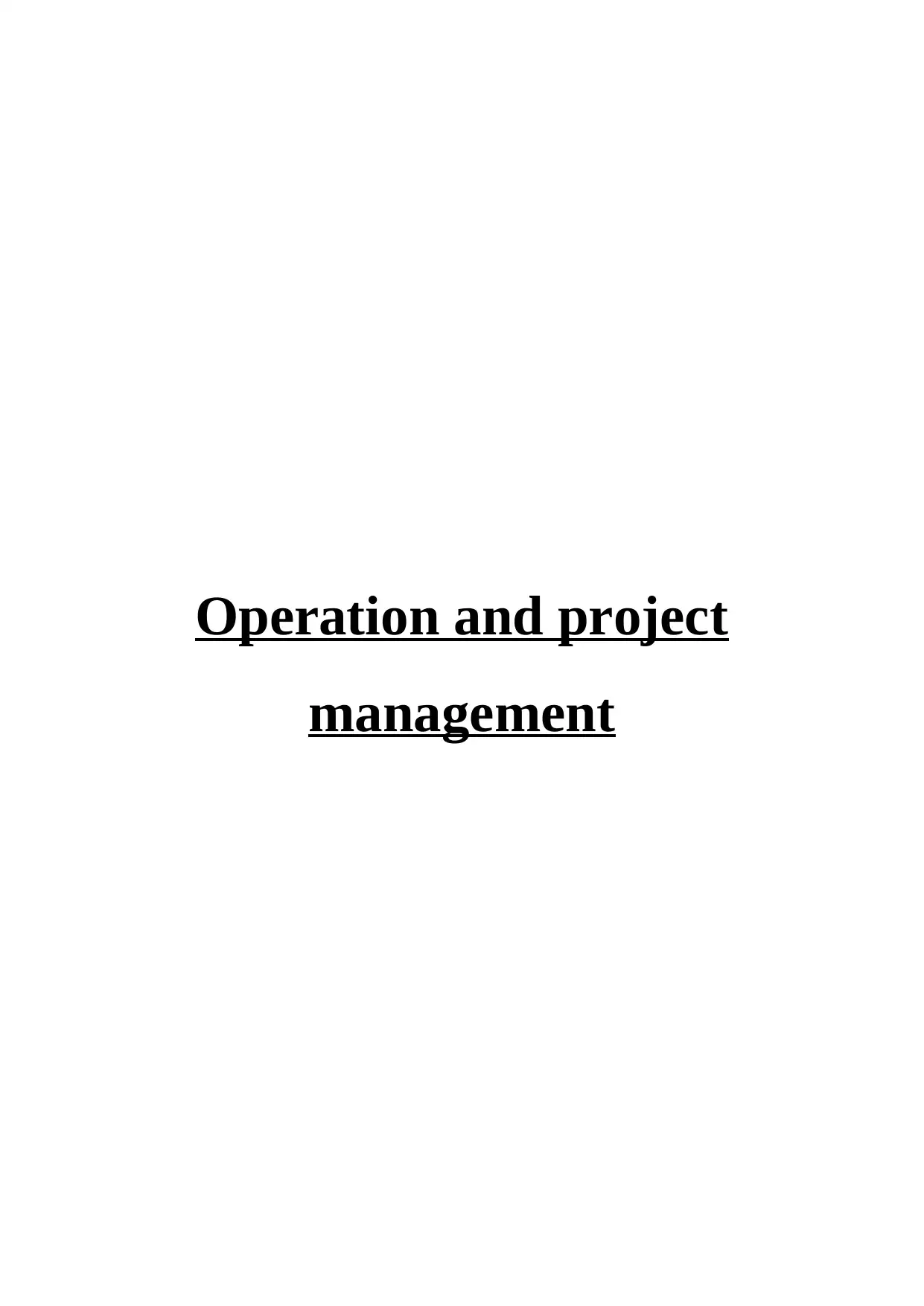
Operation and project
management
management
Paraphrase This Document
Need a fresh take? Get an instant paraphrase of this document with our AI Paraphraser
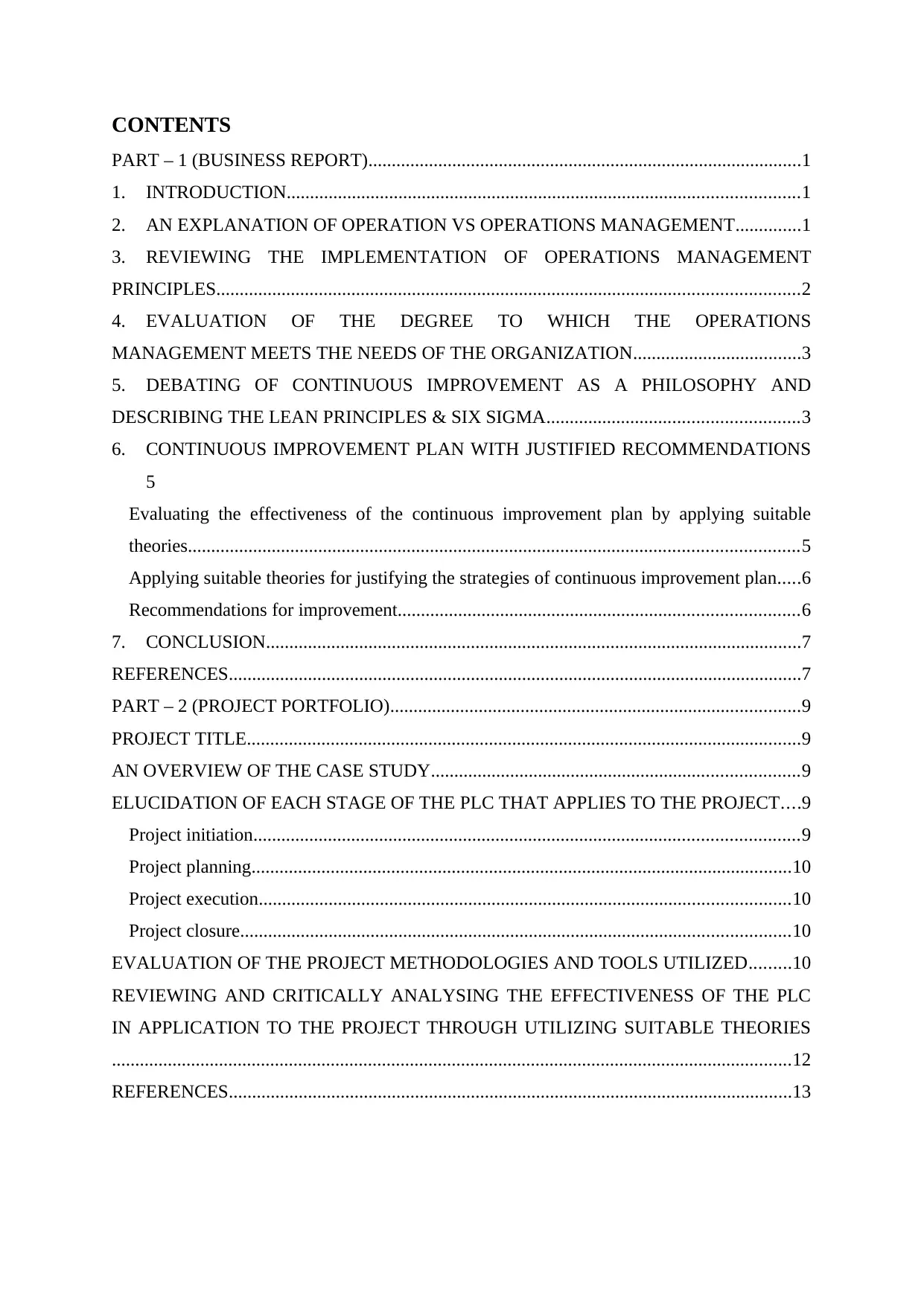
CONTENTS
PART – 1 (BUSINESS REPORT).............................................................................................1
1. INTRODUCTION..............................................................................................................1
2. AN EXPLANATION OF OPERATION VS OPERATIONS MANAGEMENT..............1
3. REVIEWING THE IMPLEMENTATION OF OPERATIONS MANAGEMENT
PRINCIPLES.............................................................................................................................2
4. EVALUATION OF THE DEGREE TO WHICH THE OPERATIONS
MANAGEMENT MEETS THE NEEDS OF THE ORGANIZATION....................................3
5. DEBATING OF CONTINUOUS IMPROVEMENT AS A PHILOSOPHY AND
DESCRIBING THE LEAN PRINCIPLES & SIX SIGMA......................................................3
6. CONTINUOUS IMPROVEMENT PLAN WITH JUSTIFIED RECOMMENDATIONS
5
Evaluating the effectiveness of the continuous improvement plan by applying suitable
theories...................................................................................................................................5
Applying suitable theories for justifying the strategies of continuous improvement plan.....6
Recommendations for improvement......................................................................................6
7. CONCLUSION...................................................................................................................7
REFERENCES...........................................................................................................................7
PART – 2 (PROJECT PORTFOLIO)........................................................................................9
PROJECT TITLE.......................................................................................................................9
AN OVERVIEW OF THE CASE STUDY...............................................................................9
ELUCIDATION OF EACH STAGE OF THE PLC THAT APPLIES TO THE PROJECT....9
Project initiation.....................................................................................................................9
Project planning....................................................................................................................10
Project execution..................................................................................................................10
Project closure......................................................................................................................10
EVALUATION OF THE PROJECT METHODOLOGIES AND TOOLS UTILIZED.........10
REVIEWING AND CRITICALLY ANALYSING THE EFFECTIVENESS OF THE PLC
IN APPLICATION TO THE PROJECT THROUGH UTILIZING SUITABLE THEORIES
..................................................................................................................................................12
REFERENCES.........................................................................................................................13
PART – 1 (BUSINESS REPORT).............................................................................................1
1. INTRODUCTION..............................................................................................................1
2. AN EXPLANATION OF OPERATION VS OPERATIONS MANAGEMENT..............1
3. REVIEWING THE IMPLEMENTATION OF OPERATIONS MANAGEMENT
PRINCIPLES.............................................................................................................................2
4. EVALUATION OF THE DEGREE TO WHICH THE OPERATIONS
MANAGEMENT MEETS THE NEEDS OF THE ORGANIZATION....................................3
5. DEBATING OF CONTINUOUS IMPROVEMENT AS A PHILOSOPHY AND
DESCRIBING THE LEAN PRINCIPLES & SIX SIGMA......................................................3
6. CONTINUOUS IMPROVEMENT PLAN WITH JUSTIFIED RECOMMENDATIONS
5
Evaluating the effectiveness of the continuous improvement plan by applying suitable
theories...................................................................................................................................5
Applying suitable theories for justifying the strategies of continuous improvement plan.....6
Recommendations for improvement......................................................................................6
7. CONCLUSION...................................................................................................................7
REFERENCES...........................................................................................................................7
PART – 2 (PROJECT PORTFOLIO)........................................................................................9
PROJECT TITLE.......................................................................................................................9
AN OVERVIEW OF THE CASE STUDY...............................................................................9
ELUCIDATION OF EACH STAGE OF THE PLC THAT APPLIES TO THE PROJECT....9
Project initiation.....................................................................................................................9
Project planning....................................................................................................................10
Project execution..................................................................................................................10
Project closure......................................................................................................................10
EVALUATION OF THE PROJECT METHODOLOGIES AND TOOLS UTILIZED.........10
REVIEWING AND CRITICALLY ANALYSING THE EFFECTIVENESS OF THE PLC
IN APPLICATION TO THE PROJECT THROUGH UTILIZING SUITABLE THEORIES
..................................................................................................................................................12
REFERENCES.........................................................................................................................13
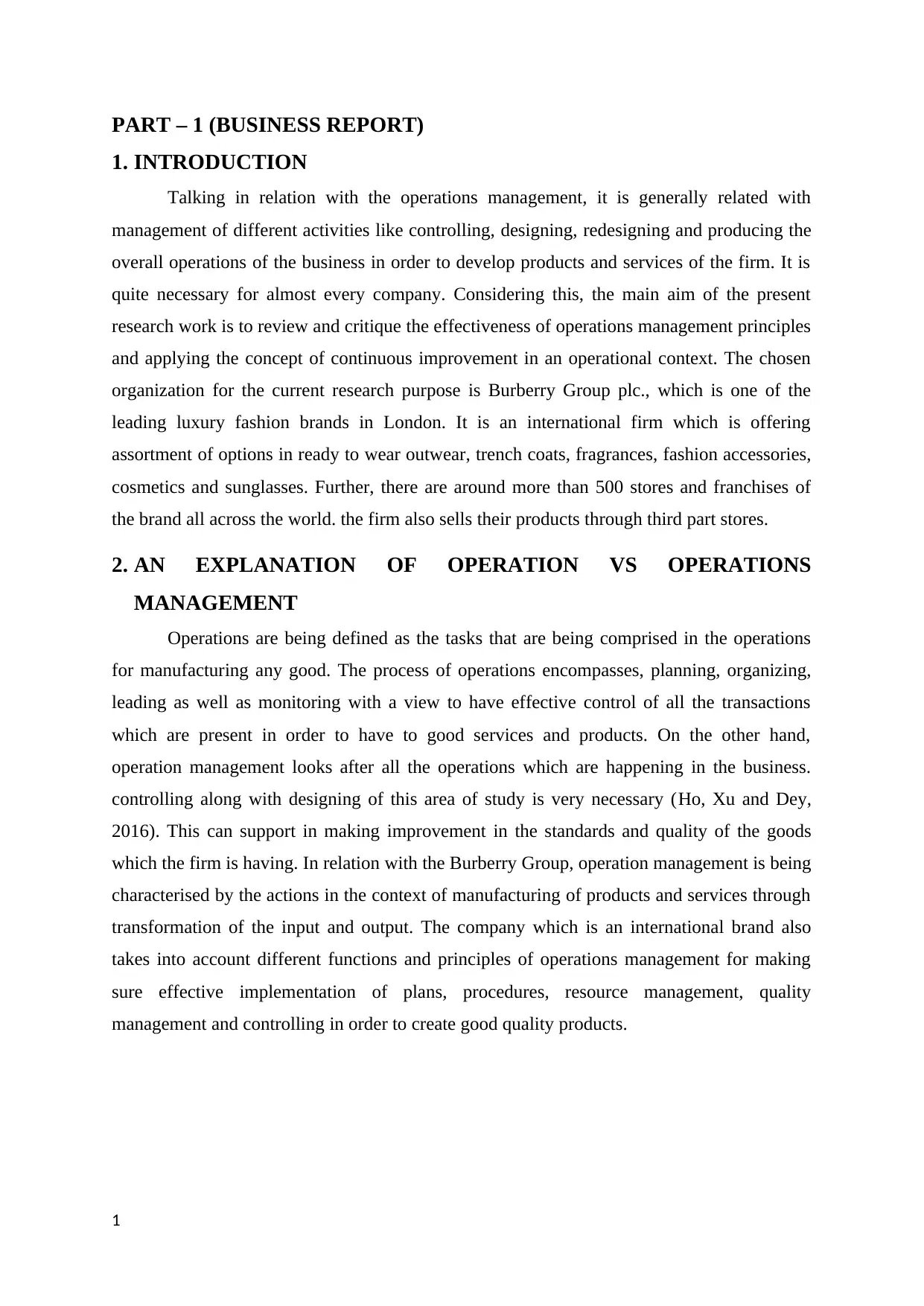
PART – 1 (BUSINESS REPORT)
1. INTRODUCTION
Talking in relation with the operations management, it is generally related with
management of different activities like controlling, designing, redesigning and producing the
overall operations of the business in order to develop products and services of the firm. It is
quite necessary for almost every company. Considering this, the main aim of the present
research work is to review and critique the effectiveness of operations management principles
and applying the concept of continuous improvement in an operational context. The chosen
organization for the current research purpose is Burberry Group plc., which is one of the
leading luxury fashion brands in London. It is an international firm which is offering
assortment of options in ready to wear outwear, trench coats, fragrances, fashion accessories,
cosmetics and sunglasses. Further, there are around more than 500 stores and franchises of
the brand all across the world. the firm also sells their products through third part stores.
2. AN EXPLANATION OF OPERATION VS OPERATIONS
MANAGEMENT
Operations are being defined as the tasks that are being comprised in the operations
for manufacturing any good. The process of operations encompasses, planning, organizing,
leading as well as monitoring with a view to have effective control of all the transactions
which are present in order to have to good services and products. On the other hand,
operation management looks after all the operations which are happening in the business.
controlling along with designing of this area of study is very necessary (Ho, Xu and Dey,
2016). This can support in making improvement in the standards and quality of the goods
which the firm is having. In relation with the Burberry Group, operation management is being
characterised by the actions in the context of manufacturing of products and services through
transformation of the input and output. The company which is an international brand also
takes into account different functions and principles of operations management for making
sure effective implementation of plans, procedures, resource management, quality
management and controlling in order to create good quality products.
1
1. INTRODUCTION
Talking in relation with the operations management, it is generally related with
management of different activities like controlling, designing, redesigning and producing the
overall operations of the business in order to develop products and services of the firm. It is
quite necessary for almost every company. Considering this, the main aim of the present
research work is to review and critique the effectiveness of operations management principles
and applying the concept of continuous improvement in an operational context. The chosen
organization for the current research purpose is Burberry Group plc., which is one of the
leading luxury fashion brands in London. It is an international firm which is offering
assortment of options in ready to wear outwear, trench coats, fragrances, fashion accessories,
cosmetics and sunglasses. Further, there are around more than 500 stores and franchises of
the brand all across the world. the firm also sells their products through third part stores.
2. AN EXPLANATION OF OPERATION VS OPERATIONS
MANAGEMENT
Operations are being defined as the tasks that are being comprised in the operations
for manufacturing any good. The process of operations encompasses, planning, organizing,
leading as well as monitoring with a view to have effective control of all the transactions
which are present in order to have to good services and products. On the other hand,
operation management looks after all the operations which are happening in the business.
controlling along with designing of this area of study is very necessary (Ho, Xu and Dey,
2016). This can support in making improvement in the standards and quality of the goods
which the firm is having. In relation with the Burberry Group, operation management is being
characterised by the actions in the context of manufacturing of products and services through
transformation of the input and output. The company which is an international brand also
takes into account different functions and principles of operations management for making
sure effective implementation of plans, procedures, resource management, quality
management and controlling in order to create good quality products.
1
⊘ This is a preview!⊘
Do you want full access?
Subscribe today to unlock all pages.

Trusted by 1+ million students worldwide
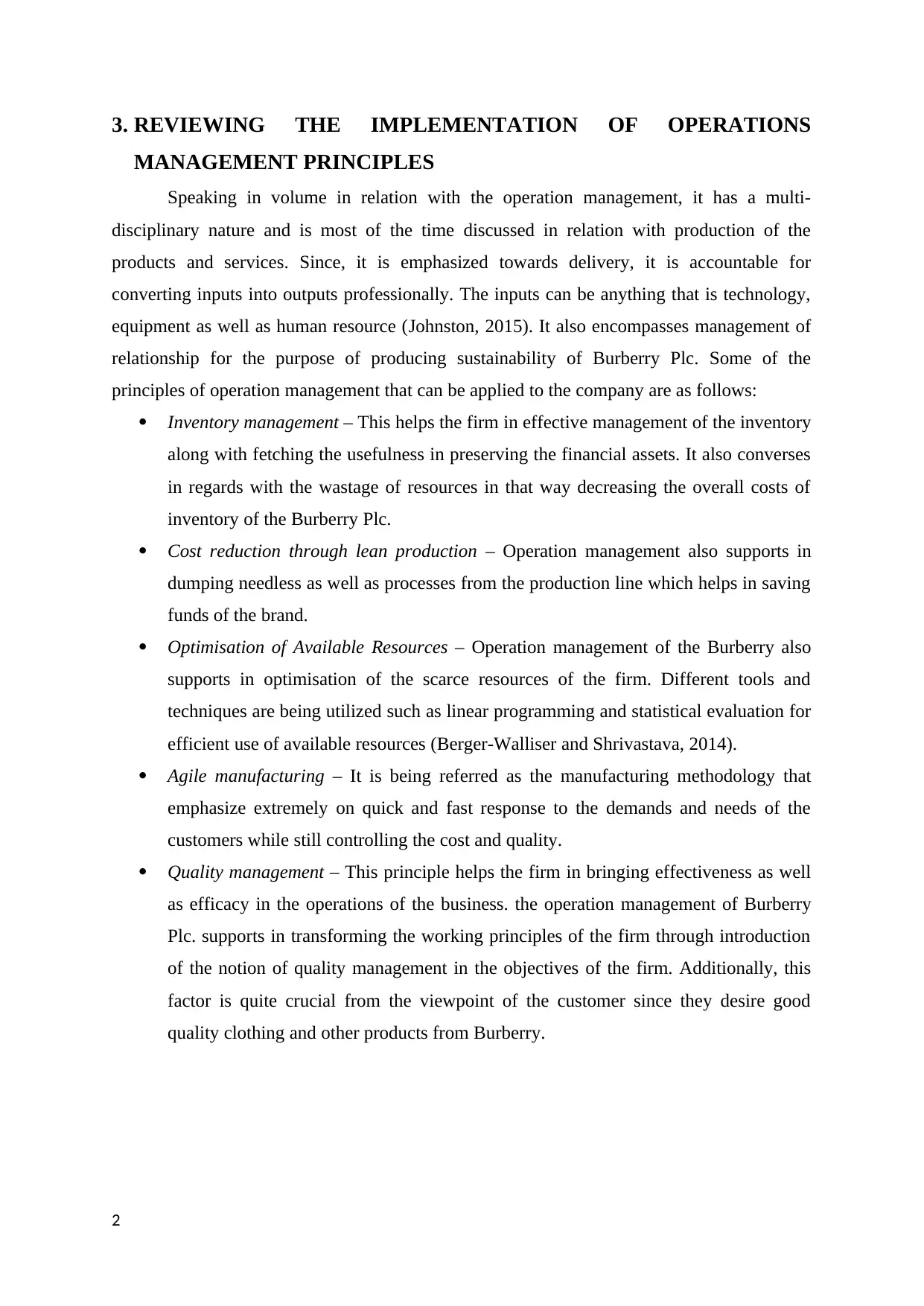
3. REVIEWING THE IMPLEMENTATION OF OPERATIONS
MANAGEMENT PRINCIPLES
Speaking in volume in relation with the operation management, it has a multi-
disciplinary nature and is most of the time discussed in relation with production of the
products and services. Since, it is emphasized towards delivery, it is accountable for
converting inputs into outputs professionally. The inputs can be anything that is technology,
equipment as well as human resource (Johnston, 2015). It also encompasses management of
relationship for the purpose of producing sustainability of Burberry Plc. Some of the
principles of operation management that can be applied to the company are as follows:
Inventory management – This helps the firm in effective management of the inventory
along with fetching the usefulness in preserving the financial assets. It also converses
in regards with the wastage of resources in that way decreasing the overall costs of
inventory of the Burberry Plc.
Cost reduction through lean production – Operation management also supports in
dumping needless as well as processes from the production line which helps in saving
funds of the brand.
Optimisation of Available Resources – Operation management of the Burberry also
supports in optimisation of the scarce resources of the firm. Different tools and
techniques are being utilized such as linear programming and statistical evaluation for
efficient use of available resources (Berger-Walliser and Shrivastava, 2014).
Agile manufacturing – It is being referred as the manufacturing methodology that
emphasize extremely on quick and fast response to the demands and needs of the
customers while still controlling the cost and quality.
Quality management – This principle helps the firm in bringing effectiveness as well
as efficacy in the operations of the business. the operation management of Burberry
Plc. supports in transforming the working principles of the firm through introduction
of the notion of quality management in the objectives of the firm. Additionally, this
factor is quite crucial from the viewpoint of the customer since they desire good
quality clothing and other products from Burberry.
2
MANAGEMENT PRINCIPLES
Speaking in volume in relation with the operation management, it has a multi-
disciplinary nature and is most of the time discussed in relation with production of the
products and services. Since, it is emphasized towards delivery, it is accountable for
converting inputs into outputs professionally. The inputs can be anything that is technology,
equipment as well as human resource (Johnston, 2015). It also encompasses management of
relationship for the purpose of producing sustainability of Burberry Plc. Some of the
principles of operation management that can be applied to the company are as follows:
Inventory management – This helps the firm in effective management of the inventory
along with fetching the usefulness in preserving the financial assets. It also converses
in regards with the wastage of resources in that way decreasing the overall costs of
inventory of the Burberry Plc.
Cost reduction through lean production – Operation management also supports in
dumping needless as well as processes from the production line which helps in saving
funds of the brand.
Optimisation of Available Resources – Operation management of the Burberry also
supports in optimisation of the scarce resources of the firm. Different tools and
techniques are being utilized such as linear programming and statistical evaluation for
efficient use of available resources (Berger-Walliser and Shrivastava, 2014).
Agile manufacturing – It is being referred as the manufacturing methodology that
emphasize extremely on quick and fast response to the demands and needs of the
customers while still controlling the cost and quality.
Quality management – This principle helps the firm in bringing effectiveness as well
as efficacy in the operations of the business. the operation management of Burberry
Plc. supports in transforming the working principles of the firm through introduction
of the notion of quality management in the objectives of the firm. Additionally, this
factor is quite crucial from the viewpoint of the customer since they desire good
quality clothing and other products from Burberry.
2
Paraphrase This Document
Need a fresh take? Get an instant paraphrase of this document with our AI Paraphraser
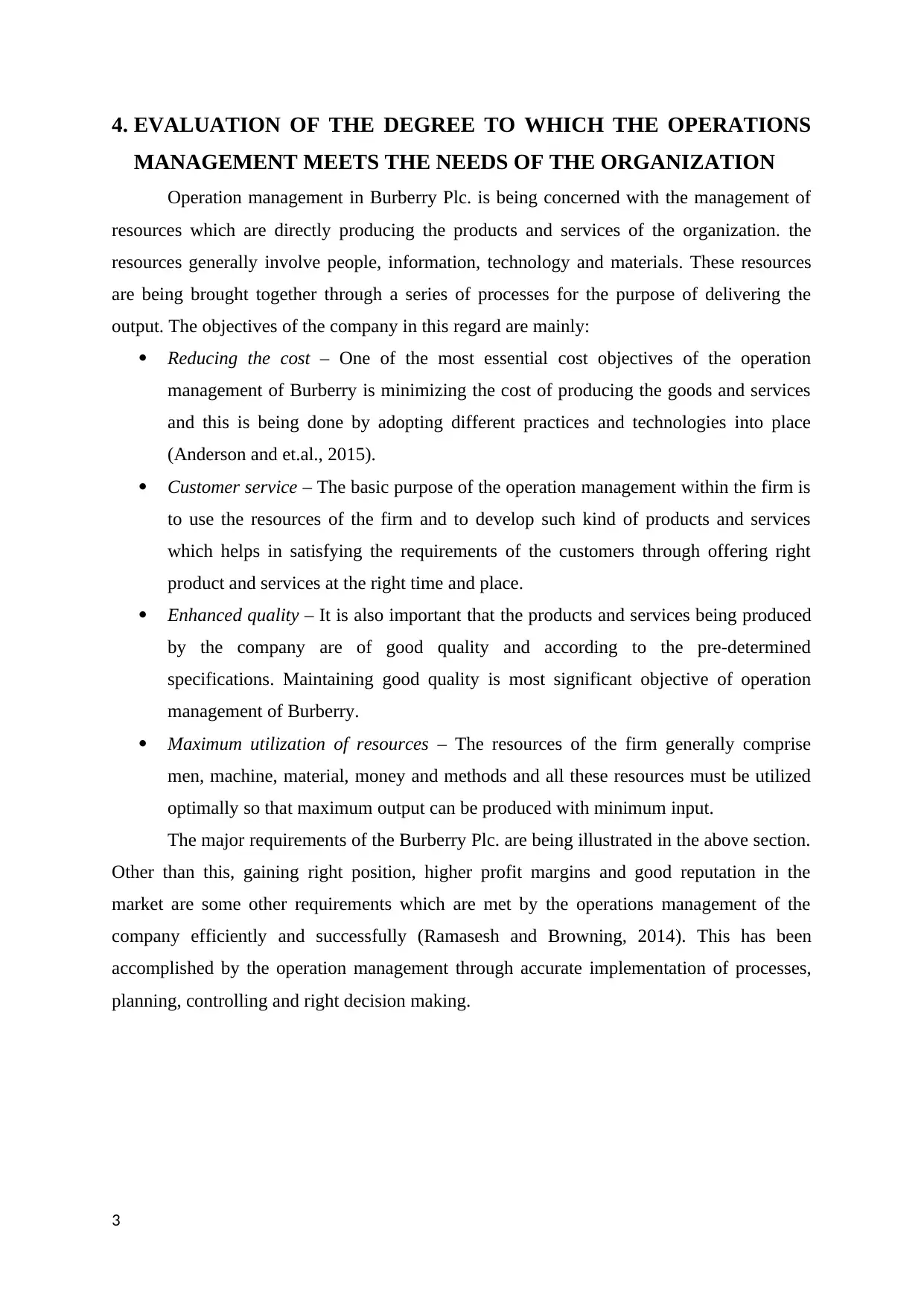
4. EVALUATION OF THE DEGREE TO WHICH THE OPERATIONS
MANAGEMENT MEETS THE NEEDS OF THE ORGANIZATION
Operation management in Burberry Plc. is being concerned with the management of
resources which are directly producing the products and services of the organization. the
resources generally involve people, information, technology and materials. These resources
are being brought together through a series of processes for the purpose of delivering the
output. The objectives of the company in this regard are mainly:
Reducing the cost – One of the most essential cost objectives of the operation
management of Burberry is minimizing the cost of producing the goods and services
and this is being done by adopting different practices and technologies into place
(Anderson and et.al., 2015).
Customer service – The basic purpose of the operation management within the firm is
to use the resources of the firm and to develop such kind of products and services
which helps in satisfying the requirements of the customers through offering right
product and services at the right time and place.
Enhanced quality – It is also important that the products and services being produced
by the company are of good quality and according to the pre-determined
specifications. Maintaining good quality is most significant objective of operation
management of Burberry.
Maximum utilization of resources – The resources of the firm generally comprise
men, machine, material, money and methods and all these resources must be utilized
optimally so that maximum output can be produced with minimum input.
The major requirements of the Burberry Plc. are being illustrated in the above section.
Other than this, gaining right position, higher profit margins and good reputation in the
market are some other requirements which are met by the operations management of the
company efficiently and successfully (Ramasesh and Browning, 2014). This has been
accomplished by the operation management through accurate implementation of processes,
planning, controlling and right decision making.
3
MANAGEMENT MEETS THE NEEDS OF THE ORGANIZATION
Operation management in Burberry Plc. is being concerned with the management of
resources which are directly producing the products and services of the organization. the
resources generally involve people, information, technology and materials. These resources
are being brought together through a series of processes for the purpose of delivering the
output. The objectives of the company in this regard are mainly:
Reducing the cost – One of the most essential cost objectives of the operation
management of Burberry is minimizing the cost of producing the goods and services
and this is being done by adopting different practices and technologies into place
(Anderson and et.al., 2015).
Customer service – The basic purpose of the operation management within the firm is
to use the resources of the firm and to develop such kind of products and services
which helps in satisfying the requirements of the customers through offering right
product and services at the right time and place.
Enhanced quality – It is also important that the products and services being produced
by the company are of good quality and according to the pre-determined
specifications. Maintaining good quality is most significant objective of operation
management of Burberry.
Maximum utilization of resources – The resources of the firm generally comprise
men, machine, material, money and methods and all these resources must be utilized
optimally so that maximum output can be produced with minimum input.
The major requirements of the Burberry Plc. are being illustrated in the above section.
Other than this, gaining right position, higher profit margins and good reputation in the
market are some other requirements which are met by the operations management of the
company efficiently and successfully (Ramasesh and Browning, 2014). This has been
accomplished by the operation management through accurate implementation of processes,
planning, controlling and right decision making.
3
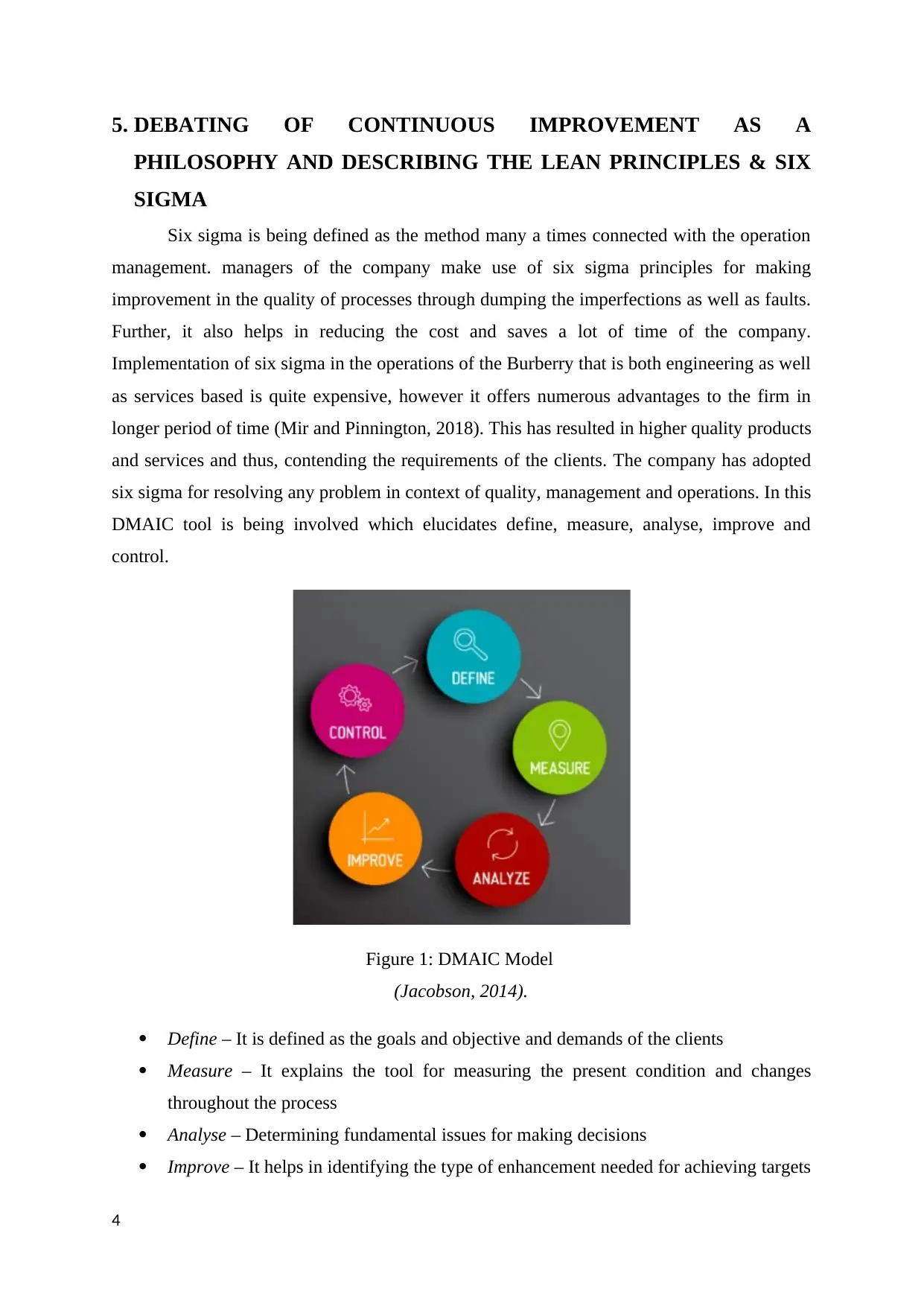
5. DEBATING OF CONTINUOUS IMPROVEMENT AS A
PHILOSOPHY AND DESCRIBING THE LEAN PRINCIPLES & SIX
SIGMA
Six sigma is being defined as the method many a times connected with the operation
management. managers of the company make use of six sigma principles for making
improvement in the quality of processes through dumping the imperfections as well as faults.
Further, it also helps in reducing the cost and saves a lot of time of the company.
Implementation of six sigma in the operations of the Burberry that is both engineering as well
as services based is quite expensive, however it offers numerous advantages to the firm in
longer period of time (Mir and Pinnington, 2018). This has resulted in higher quality products
and services and thus, contending the requirements of the clients. The company has adopted
six sigma for resolving any problem in context of quality, management and operations. In this
DMAIC tool is being involved which elucidates define, measure, analyse, improve and
control.
Figure 1: DMAIC Model
(Jacobson, 2014).
Define – It is defined as the goals and objective and demands of the clients
Measure – It explains the tool for measuring the present condition and changes
throughout the process
Analyse – Determining fundamental issues for making decisions
Improve – It helps in identifying the type of enhancement needed for achieving targets
4
PHILOSOPHY AND DESCRIBING THE LEAN PRINCIPLES & SIX
SIGMA
Six sigma is being defined as the method many a times connected with the operation
management. managers of the company make use of six sigma principles for making
improvement in the quality of processes through dumping the imperfections as well as faults.
Further, it also helps in reducing the cost and saves a lot of time of the company.
Implementation of six sigma in the operations of the Burberry that is both engineering as well
as services based is quite expensive, however it offers numerous advantages to the firm in
longer period of time (Mir and Pinnington, 2018). This has resulted in higher quality products
and services and thus, contending the requirements of the clients. The company has adopted
six sigma for resolving any problem in context of quality, management and operations. In this
DMAIC tool is being involved which elucidates define, measure, analyse, improve and
control.
Figure 1: DMAIC Model
(Jacobson, 2014).
Define – It is defined as the goals and objective and demands of the clients
Measure – It explains the tool for measuring the present condition and changes
throughout the process
Analyse – Determining fundamental issues for making decisions
Improve – It helps in identifying the type of enhancement needed for achieving targets
4
⊘ This is a preview!⊘
Do you want full access?
Subscribe today to unlock all pages.

Trusted by 1+ million students worldwide
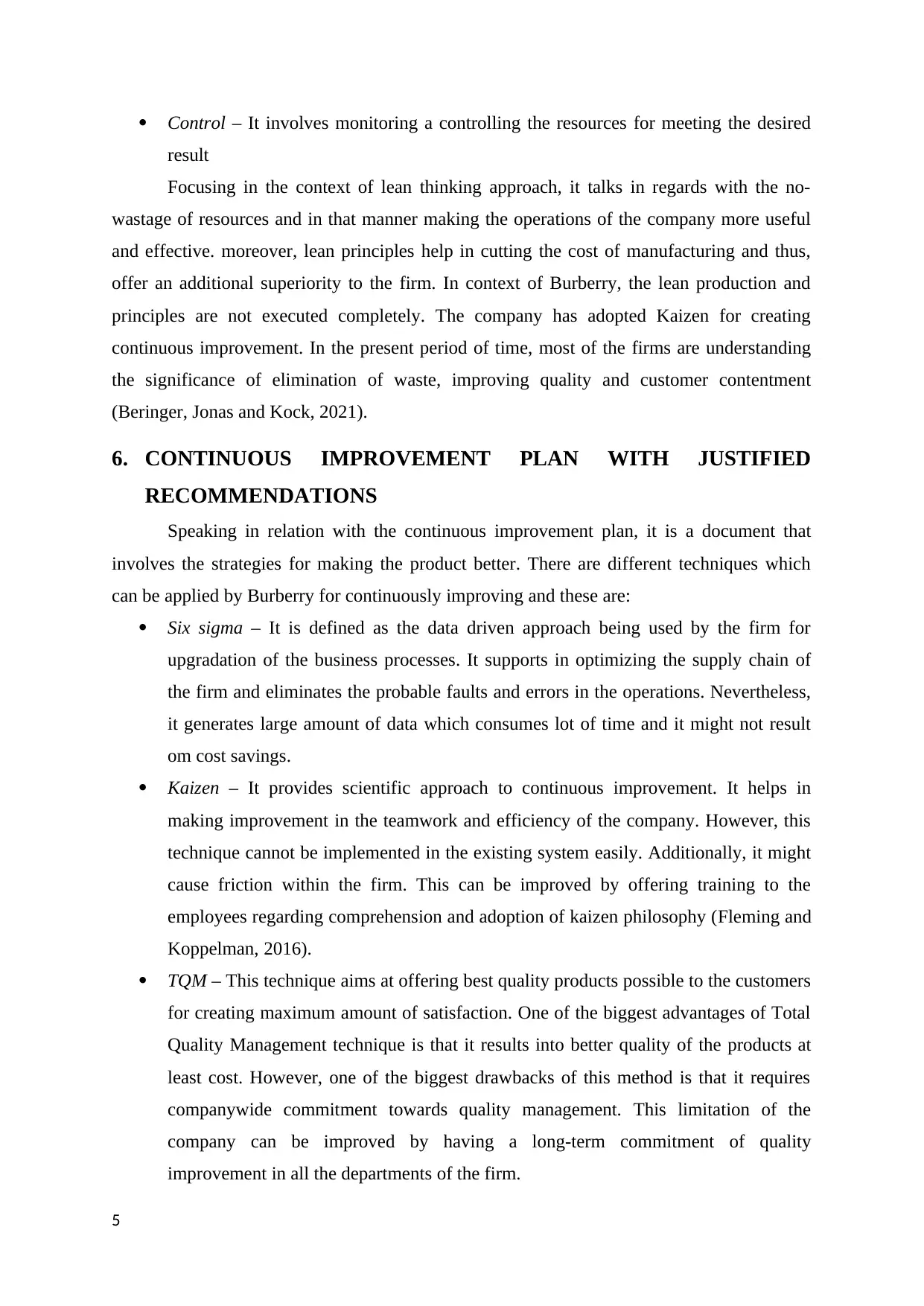
Control – It involves monitoring a controlling the resources for meeting the desired
result
Focusing in the context of lean thinking approach, it talks in regards with the no-
wastage of resources and in that manner making the operations of the company more useful
and effective. moreover, lean principles help in cutting the cost of manufacturing and thus,
offer an additional superiority to the firm. In context of Burberry, the lean production and
principles are not executed completely. The company has adopted Kaizen for creating
continuous improvement. In the present period of time, most of the firms are understanding
the significance of elimination of waste, improving quality and customer contentment
(Beringer, Jonas and Kock, 2021).
6. CONTINUOUS IMPROVEMENT PLAN WITH JUSTIFIED
RECOMMENDATIONS
Speaking in relation with the continuous improvement plan, it is a document that
involves the strategies for making the product better. There are different techniques which
can be applied by Burberry for continuously improving and these are:
Six sigma – It is defined as the data driven approach being used by the firm for
upgradation of the business processes. It supports in optimizing the supply chain of
the firm and eliminates the probable faults and errors in the operations. Nevertheless,
it generates large amount of data which consumes lot of time and it might not result
om cost savings.
Kaizen – It provides scientific approach to continuous improvement. It helps in
making improvement in the teamwork and efficiency of the company. However, this
technique cannot be implemented in the existing system easily. Additionally, it might
cause friction within the firm. This can be improved by offering training to the
employees regarding comprehension and adoption of kaizen philosophy (Fleming and
Koppelman, 2016).
TQM – This technique aims at offering best quality products possible to the customers
for creating maximum amount of satisfaction. One of the biggest advantages of Total
Quality Management technique is that it results into better quality of the products at
least cost. However, one of the biggest drawbacks of this method is that it requires
companywide commitment towards quality management. This limitation of the
company can be improved by having a long-term commitment of quality
improvement in all the departments of the firm.
5
result
Focusing in the context of lean thinking approach, it talks in regards with the no-
wastage of resources and in that manner making the operations of the company more useful
and effective. moreover, lean principles help in cutting the cost of manufacturing and thus,
offer an additional superiority to the firm. In context of Burberry, the lean production and
principles are not executed completely. The company has adopted Kaizen for creating
continuous improvement. In the present period of time, most of the firms are understanding
the significance of elimination of waste, improving quality and customer contentment
(Beringer, Jonas and Kock, 2021).
6. CONTINUOUS IMPROVEMENT PLAN WITH JUSTIFIED
RECOMMENDATIONS
Speaking in relation with the continuous improvement plan, it is a document that
involves the strategies for making the product better. There are different techniques which
can be applied by Burberry for continuously improving and these are:
Six sigma – It is defined as the data driven approach being used by the firm for
upgradation of the business processes. It supports in optimizing the supply chain of
the firm and eliminates the probable faults and errors in the operations. Nevertheless,
it generates large amount of data which consumes lot of time and it might not result
om cost savings.
Kaizen – It provides scientific approach to continuous improvement. It helps in
making improvement in the teamwork and efficiency of the company. However, this
technique cannot be implemented in the existing system easily. Additionally, it might
cause friction within the firm. This can be improved by offering training to the
employees regarding comprehension and adoption of kaizen philosophy (Fleming and
Koppelman, 2016).
TQM – This technique aims at offering best quality products possible to the customers
for creating maximum amount of satisfaction. One of the biggest advantages of Total
Quality Management technique is that it results into better quality of the products at
least cost. However, one of the biggest drawbacks of this method is that it requires
companywide commitment towards quality management. This limitation of the
company can be improved by having a long-term commitment of quality
improvement in all the departments of the firm.
5
Paraphrase This Document
Need a fresh take? Get an instant paraphrase of this document with our AI Paraphraser
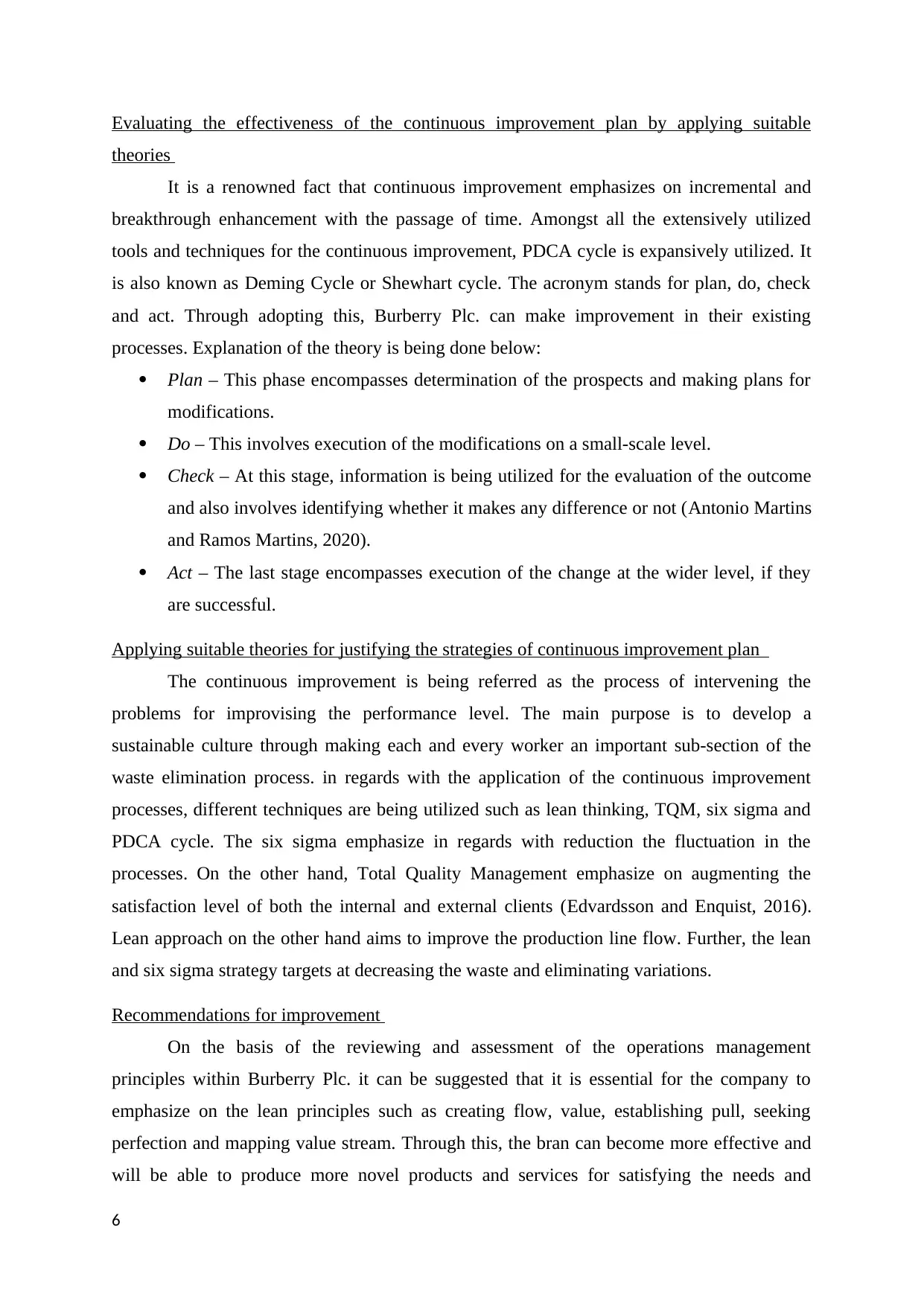
Evaluating the effectiveness of the continuous improvement plan by applying suitable
theories
It is a renowned fact that continuous improvement emphasizes on incremental and
breakthrough enhancement with the passage of time. Amongst all the extensively utilized
tools and techniques for the continuous improvement, PDCA cycle is expansively utilized. It
is also known as Deming Cycle or Shewhart cycle. The acronym stands for plan, do, check
and act. Through adopting this, Burberry Plc. can make improvement in their existing
processes. Explanation of the theory is being done below:
Plan – This phase encompasses determination of the prospects and making plans for
modifications.
Do – This involves execution of the modifications on a small-scale level.
Check – At this stage, information is being utilized for the evaluation of the outcome
and also involves identifying whether it makes any difference or not (Antonio Martins
and Ramos Martins, 2020).
Act – The last stage encompasses execution of the change at the wider level, if they
are successful.
Applying suitable theories for justifying the strategies of continuous improvement plan
The continuous improvement is being referred as the process of intervening the
problems for improvising the performance level. The main purpose is to develop a
sustainable culture through making each and every worker an important sub-section of the
waste elimination process. in regards with the application of the continuous improvement
processes, different techniques are being utilized such as lean thinking, TQM, six sigma and
PDCA cycle. The six sigma emphasize in regards with reduction the fluctuation in the
processes. On the other hand, Total Quality Management emphasize on augmenting the
satisfaction level of both the internal and external clients (Edvardsson and Enquist, 2016).
Lean approach on the other hand aims to improve the production line flow. Further, the lean
and six sigma strategy targets at decreasing the waste and eliminating variations.
Recommendations for improvement
On the basis of the reviewing and assessment of the operations management
principles within Burberry Plc. it can be suggested that it is essential for the company to
emphasize on the lean principles such as creating flow, value, establishing pull, seeking
perfection and mapping value stream. Through this, the bran can become more effective and
will be able to produce more novel products and services for satisfying the needs and
6
theories
It is a renowned fact that continuous improvement emphasizes on incremental and
breakthrough enhancement with the passage of time. Amongst all the extensively utilized
tools and techniques for the continuous improvement, PDCA cycle is expansively utilized. It
is also known as Deming Cycle or Shewhart cycle. The acronym stands for plan, do, check
and act. Through adopting this, Burberry Plc. can make improvement in their existing
processes. Explanation of the theory is being done below:
Plan – This phase encompasses determination of the prospects and making plans for
modifications.
Do – This involves execution of the modifications on a small-scale level.
Check – At this stage, information is being utilized for the evaluation of the outcome
and also involves identifying whether it makes any difference or not (Antonio Martins
and Ramos Martins, 2020).
Act – The last stage encompasses execution of the change at the wider level, if they
are successful.
Applying suitable theories for justifying the strategies of continuous improvement plan
The continuous improvement is being referred as the process of intervening the
problems for improvising the performance level. The main purpose is to develop a
sustainable culture through making each and every worker an important sub-section of the
waste elimination process. in regards with the application of the continuous improvement
processes, different techniques are being utilized such as lean thinking, TQM, six sigma and
PDCA cycle. The six sigma emphasize in regards with reduction the fluctuation in the
processes. On the other hand, Total Quality Management emphasize on augmenting the
satisfaction level of both the internal and external clients (Edvardsson and Enquist, 2016).
Lean approach on the other hand aims to improve the production line flow. Further, the lean
and six sigma strategy targets at decreasing the waste and eliminating variations.
Recommendations for improvement
On the basis of the reviewing and assessment of the operations management
principles within Burberry Plc. it can be suggested that it is essential for the company to
emphasize on the lean principles such as creating flow, value, establishing pull, seeking
perfection and mapping value stream. Through this, the bran can become more effective and
will be able to produce more novel products and services for satisfying the needs and
6
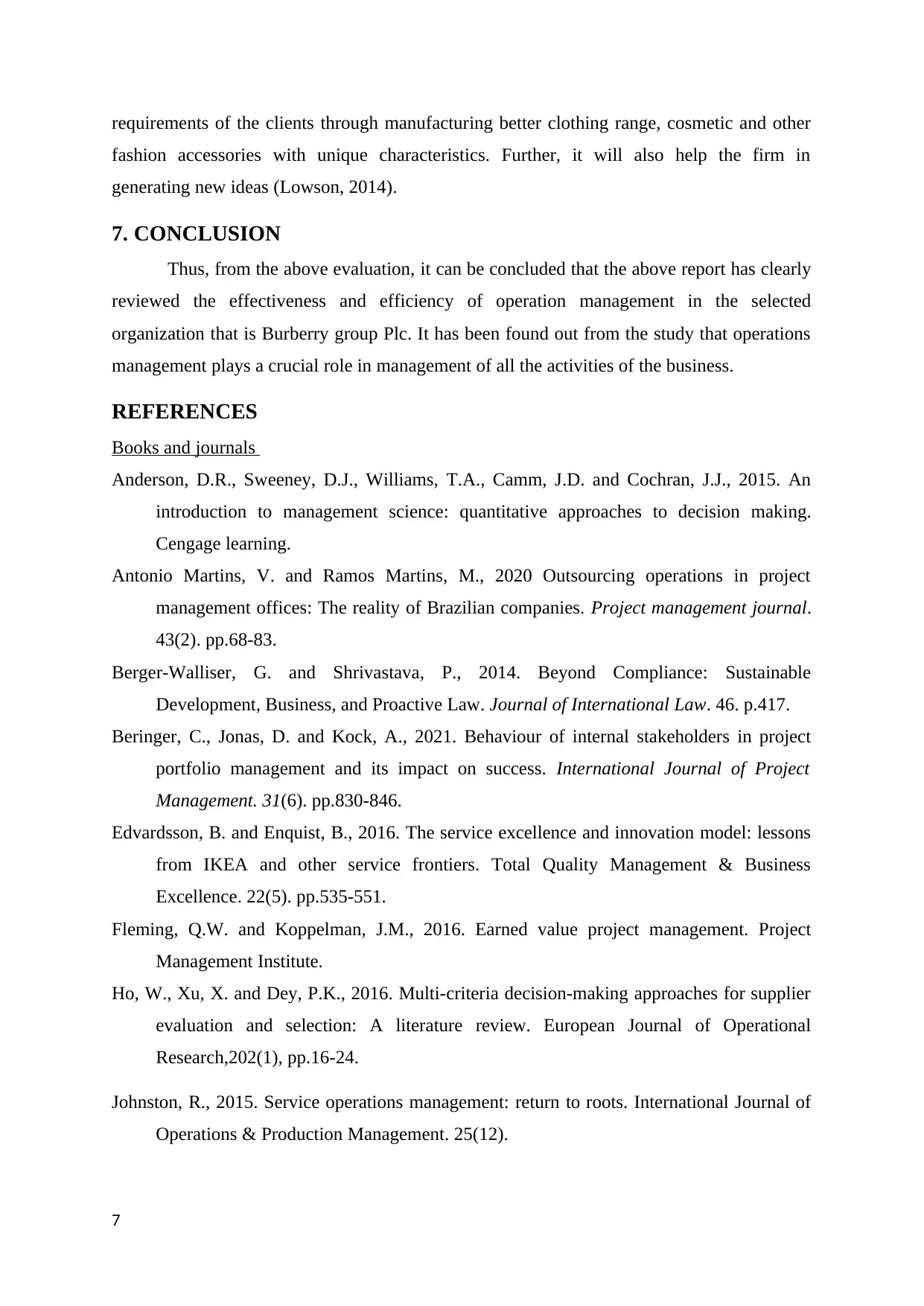
requirements of the clients through manufacturing better clothing range, cosmetic and other
fashion accessories with unique characteristics. Further, it will also help the firm in
generating new ideas (Lowson, 2014).
7. CONCLUSION
Thus, from the above evaluation, it can be concluded that the above report has clearly
reviewed the effectiveness and efficiency of operation management in the selected
organization that is Burberry group Plc. It has been found out from the study that operations
management plays a crucial role in management of all the activities of the business.
REFERENCES
Books and journals
Anderson, D.R., Sweeney, D.J., Williams, T.A., Camm, J.D. and Cochran, J.J., 2015. An
introduction to management science: quantitative approaches to decision making.
Cengage learning.
Antonio Martins, V. and Ramos Martins, M., 2020 Outsourcing operations in project
management offices: The reality of Brazilian companies. Project management journal.
43(2). pp.68-83.
Berger-Walliser, G. and Shrivastava, P., 2014. Beyond Compliance: Sustainable
Development, Business, and Proactive Law. Journal of International Law. 46. p.417.
Beringer, C., Jonas, D. and Kock, A., 2021. Behaviour of internal stakeholders in project
portfolio management and its impact on success. International Journal of Project
Management. 31(6). pp.830-846.
Edvardsson, B. and Enquist, B., 2016. The service excellence and innovation model: lessons
from IKEA and other service frontiers. Total Quality Management & Business
Excellence. 22(5). pp.535-551.
Fleming, Q.W. and Koppelman, J.M., 2016. Earned value project management. Project
Management Institute.
Ho, W., Xu, X. and Dey, P.K., 2016. Multi-criteria decision-making approaches for supplier
evaluation and selection: A literature review. European Journal of Operational
Research,202(1), pp.16-24.
Johnston, R., 2015. Service operations management: return to roots. International Journal of
Operations & Production Management. 25(12).
7
fashion accessories with unique characteristics. Further, it will also help the firm in
generating new ideas (Lowson, 2014).
7. CONCLUSION
Thus, from the above evaluation, it can be concluded that the above report has clearly
reviewed the effectiveness and efficiency of operation management in the selected
organization that is Burberry group Plc. It has been found out from the study that operations
management plays a crucial role in management of all the activities of the business.
REFERENCES
Books and journals
Anderson, D.R., Sweeney, D.J., Williams, T.A., Camm, J.D. and Cochran, J.J., 2015. An
introduction to management science: quantitative approaches to decision making.
Cengage learning.
Antonio Martins, V. and Ramos Martins, M., 2020 Outsourcing operations in project
management offices: The reality of Brazilian companies. Project management journal.
43(2). pp.68-83.
Berger-Walliser, G. and Shrivastava, P., 2014. Beyond Compliance: Sustainable
Development, Business, and Proactive Law. Journal of International Law. 46. p.417.
Beringer, C., Jonas, D. and Kock, A., 2021. Behaviour of internal stakeholders in project
portfolio management and its impact on success. International Journal of Project
Management. 31(6). pp.830-846.
Edvardsson, B. and Enquist, B., 2016. The service excellence and innovation model: lessons
from IKEA and other service frontiers. Total Quality Management & Business
Excellence. 22(5). pp.535-551.
Fleming, Q.W. and Koppelman, J.M., 2016. Earned value project management. Project
Management Institute.
Ho, W., Xu, X. and Dey, P.K., 2016. Multi-criteria decision-making approaches for supplier
evaluation and selection: A literature review. European Journal of Operational
Research,202(1), pp.16-24.
Johnston, R., 2015. Service operations management: return to roots. International Journal of
Operations & Production Management. 25(12).
7
⊘ This is a preview!⊘
Do you want full access?
Subscribe today to unlock all pages.

Trusted by 1+ million students worldwide
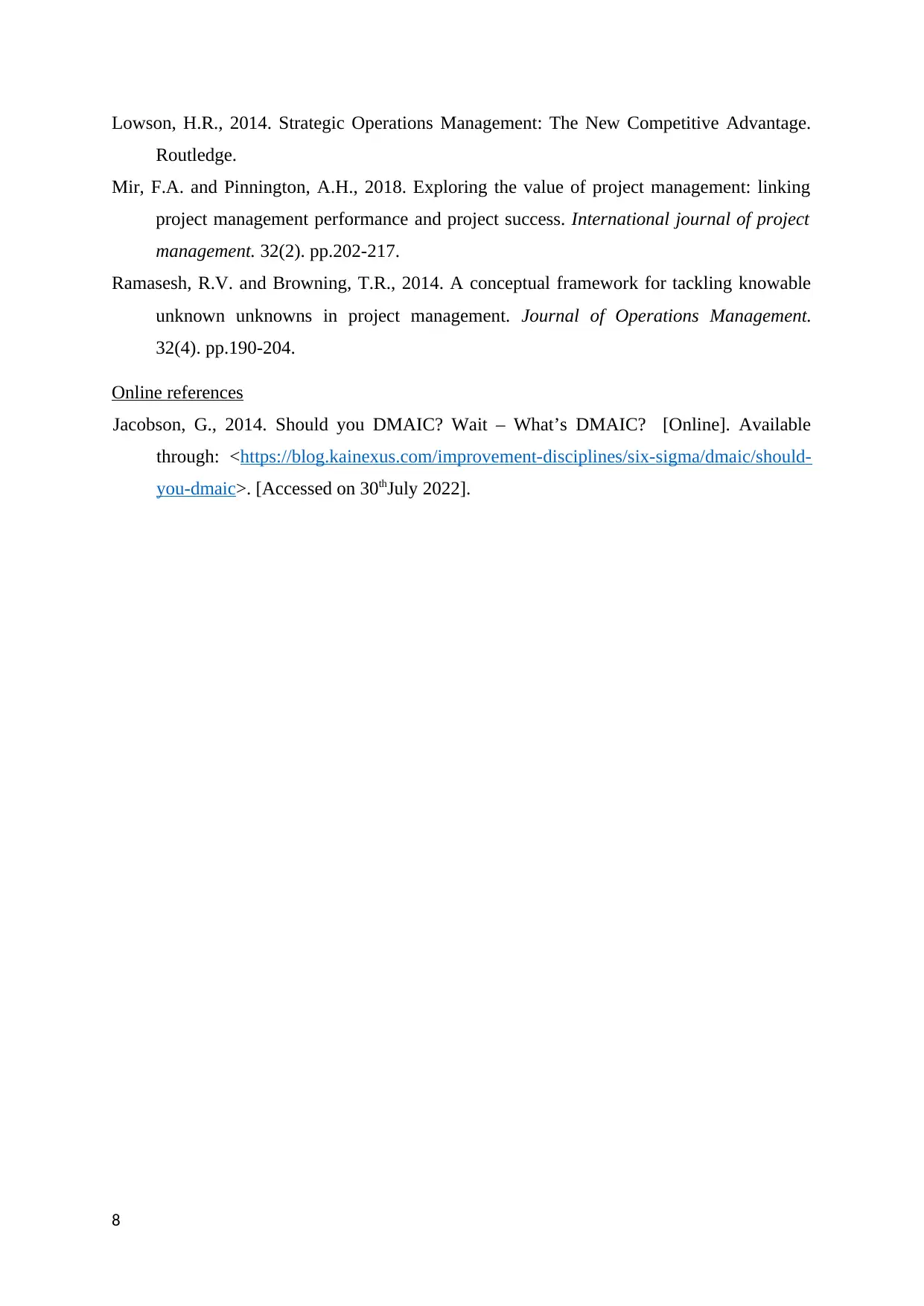
Lowson, H.R., 2014. Strategic Operations Management: The New Competitive Advantage.
Routledge.
Mir, F.A. and Pinnington, A.H., 2018. Exploring the value of project management: linking
project management performance and project success. International journal of project
management. 32(2). pp.202-217.
Ramasesh, R.V. and Browning, T.R., 2014. A conceptual framework for tackling knowable
unknown unknowns in project management. Journal of Operations Management.
32(4). pp.190-204.
Online references
Jacobson, G., 2014. Should you DMAIC? Wait – What’s DMAIC? [Online]. Available
through: <https://blog.kainexus.com/improvement-disciplines/six-sigma/dmaic/should-
you-dmaic>. [Accessed on 30thJuly 2022].
8
Routledge.
Mir, F.A. and Pinnington, A.H., 2018. Exploring the value of project management: linking
project management performance and project success. International journal of project
management. 32(2). pp.202-217.
Ramasesh, R.V. and Browning, T.R., 2014. A conceptual framework for tackling knowable
unknown unknowns in project management. Journal of Operations Management.
32(4). pp.190-204.
Online references
Jacobson, G., 2014. Should you DMAIC? Wait – What’s DMAIC? [Online]. Available
through: <https://blog.kainexus.com/improvement-disciplines/six-sigma/dmaic/should-
you-dmaic>. [Accessed on 30thJuly 2022].
8
Paraphrase This Document
Need a fresh take? Get an instant paraphrase of this document with our AI Paraphraser
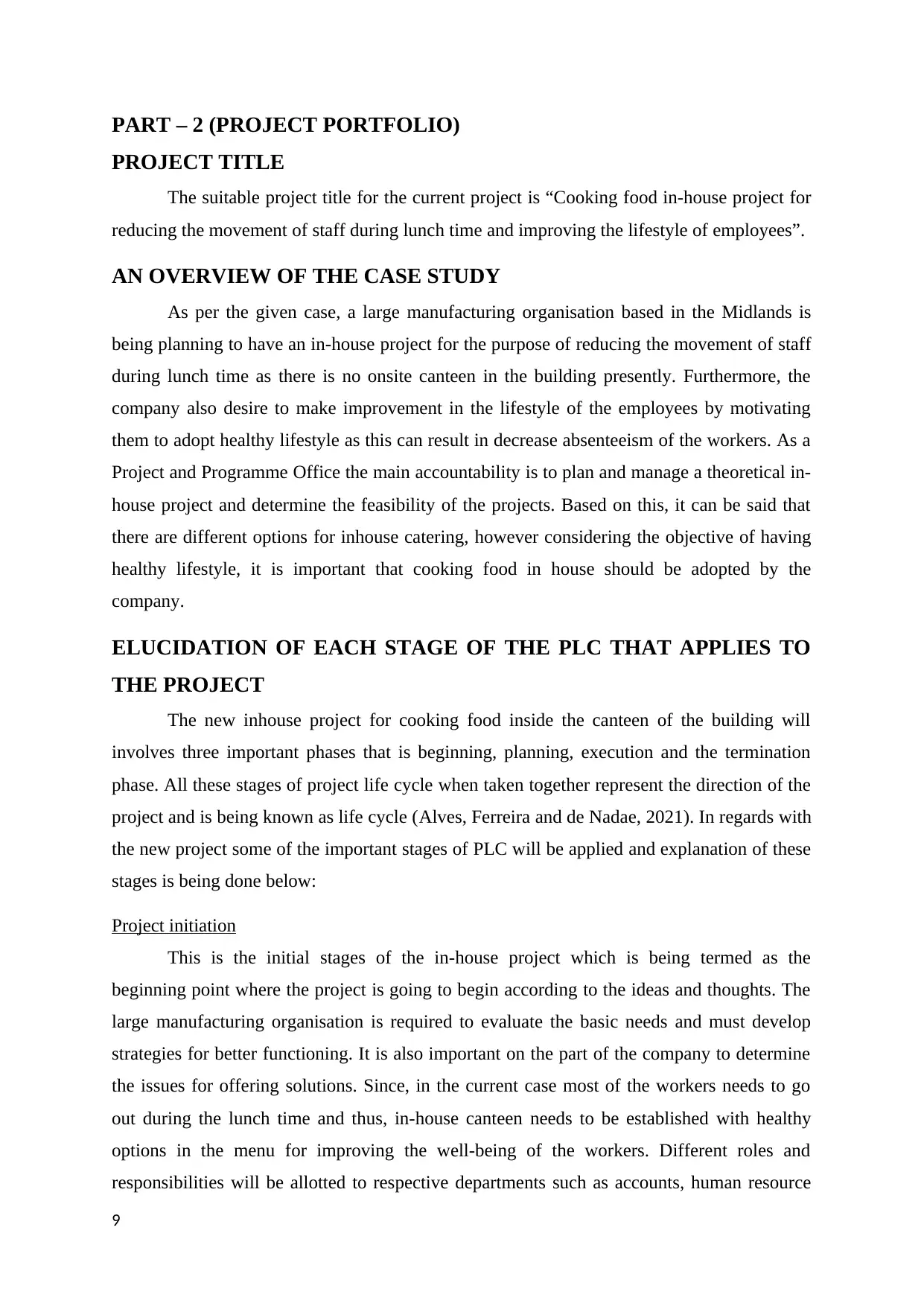
PART – 2 (PROJECT PORTFOLIO)
PROJECT TITLE
The suitable project title for the current project is “Cooking food in-house project for
reducing the movement of staff during lunch time and improving the lifestyle of employees”.
AN OVERVIEW OF THE CASE STUDY
As per the given case, a large manufacturing organisation based in the Midlands is
being planning to have an in-house project for the purpose of reducing the movement of staff
during lunch time as there is no onsite canteen in the building presently. Furthermore, the
company also desire to make improvement in the lifestyle of the employees by motivating
them to adopt healthy lifestyle as this can result in decrease absenteeism of the workers. As a
Project and Programme Office the main accountability is to plan and manage a theoretical in-
house project and determine the feasibility of the projects. Based on this, it can be said that
there are different options for inhouse catering, however considering the objective of having
healthy lifestyle, it is important that cooking food in house should be adopted by the
company.
ELUCIDATION OF EACH STAGE OF THE PLC THAT APPLIES TO
THE PROJECT
The new inhouse project for cooking food inside the canteen of the building will
involves three important phases that is beginning, planning, execution and the termination
phase. All these stages of project life cycle when taken together represent the direction of the
project and is being known as life cycle (Alves, Ferreira and de Nadae, 2021). In regards with
the new project some of the important stages of PLC will be applied and explanation of these
stages is being done below:
Project initiation
This is the initial stages of the in-house project which is being termed as the
beginning point where the project is going to begin according to the ideas and thoughts. The
large manufacturing organisation is required to evaluate the basic needs and must develop
strategies for better functioning. It is also important on the part of the company to determine
the issues for offering solutions. Since, in the current case most of the workers needs to go
out during the lunch time and thus, in-house canteen needs to be established with healthy
options in the menu for improving the well-being of the workers. Different roles and
responsibilities will be allotted to respective departments such as accounts, human resource
9
PROJECT TITLE
The suitable project title for the current project is “Cooking food in-house project for
reducing the movement of staff during lunch time and improving the lifestyle of employees”.
AN OVERVIEW OF THE CASE STUDY
As per the given case, a large manufacturing organisation based in the Midlands is
being planning to have an in-house project for the purpose of reducing the movement of staff
during lunch time as there is no onsite canteen in the building presently. Furthermore, the
company also desire to make improvement in the lifestyle of the employees by motivating
them to adopt healthy lifestyle as this can result in decrease absenteeism of the workers. As a
Project and Programme Office the main accountability is to plan and manage a theoretical in-
house project and determine the feasibility of the projects. Based on this, it can be said that
there are different options for inhouse catering, however considering the objective of having
healthy lifestyle, it is important that cooking food in house should be adopted by the
company.
ELUCIDATION OF EACH STAGE OF THE PLC THAT APPLIES TO
THE PROJECT
The new inhouse project for cooking food inside the canteen of the building will
involves three important phases that is beginning, planning, execution and the termination
phase. All these stages of project life cycle when taken together represent the direction of the
project and is being known as life cycle (Alves, Ferreira and de Nadae, 2021). In regards with
the new project some of the important stages of PLC will be applied and explanation of these
stages is being done below:
Project initiation
This is the initial stages of the in-house project which is being termed as the
beginning point where the project is going to begin according to the ideas and thoughts. The
large manufacturing organisation is required to evaluate the basic needs and must develop
strategies for better functioning. It is also important on the part of the company to determine
the issues for offering solutions. Since, in the current case most of the workers needs to go
out during the lunch time and thus, in-house canteen needs to be established with healthy
options in the menu for improving the well-being of the workers. Different roles and
responsibilities will be allotted to respective departments such as accounts, human resource
9
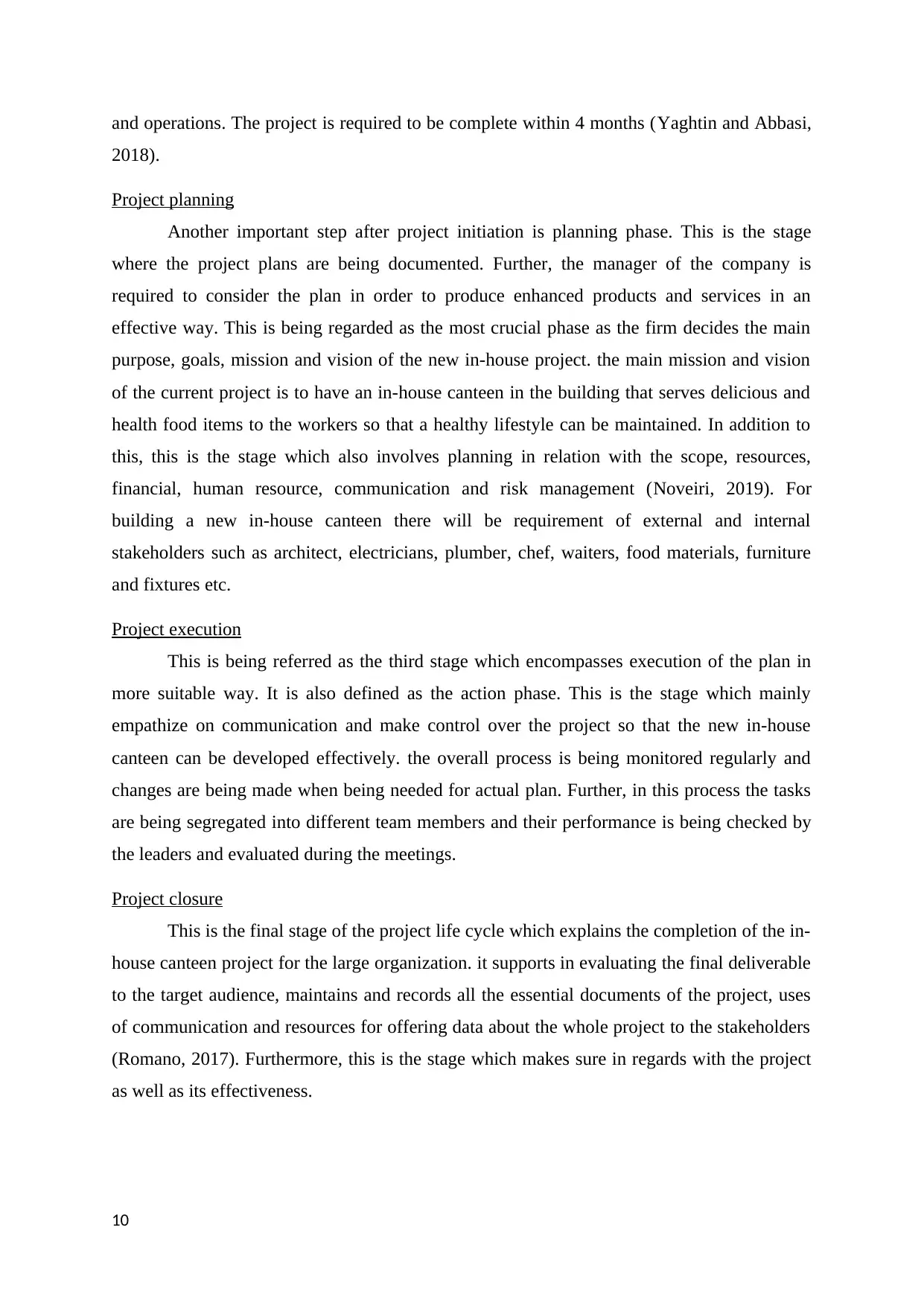
and operations. The project is required to be complete within 4 months (Yaghtin and Abbasi,
2018).
Project planning
Another important step after project initiation is planning phase. This is the stage
where the project plans are being documented. Further, the manager of the company is
required to consider the plan in order to produce enhanced products and services in an
effective way. This is being regarded as the most crucial phase as the firm decides the main
purpose, goals, mission and vision of the new in-house project. the main mission and vision
of the current project is to have an in-house canteen in the building that serves delicious and
health food items to the workers so that a healthy lifestyle can be maintained. In addition to
this, this is the stage which also involves planning in relation with the scope, resources,
financial, human resource, communication and risk management (Noveiri, 2019). For
building a new in-house canteen there will be requirement of external and internal
stakeholders such as architect, electricians, plumber, chef, waiters, food materials, furniture
and fixtures etc.
Project execution
This is being referred as the third stage which encompasses execution of the plan in
more suitable way. It is also defined as the action phase. This is the stage which mainly
empathize on communication and make control over the project so that the new in-house
canteen can be developed effectively. the overall process is being monitored regularly and
changes are being made when being needed for actual plan. Further, in this process the tasks
are being segregated into different team members and their performance is being checked by
the leaders and evaluated during the meetings.
Project closure
This is the final stage of the project life cycle which explains the completion of the in-
house canteen project for the large organization. it supports in evaluating the final deliverable
to the target audience, maintains and records all the essential documents of the project, uses
of communication and resources for offering data about the whole project to the stakeholders
(Romano, 2017). Furthermore, this is the stage which makes sure in regards with the project
as well as its effectiveness.
10
2018).
Project planning
Another important step after project initiation is planning phase. This is the stage
where the project plans are being documented. Further, the manager of the company is
required to consider the plan in order to produce enhanced products and services in an
effective way. This is being regarded as the most crucial phase as the firm decides the main
purpose, goals, mission and vision of the new in-house project. the main mission and vision
of the current project is to have an in-house canteen in the building that serves delicious and
health food items to the workers so that a healthy lifestyle can be maintained. In addition to
this, this is the stage which also involves planning in relation with the scope, resources,
financial, human resource, communication and risk management (Noveiri, 2019). For
building a new in-house canteen there will be requirement of external and internal
stakeholders such as architect, electricians, plumber, chef, waiters, food materials, furniture
and fixtures etc.
Project execution
This is being referred as the third stage which encompasses execution of the plan in
more suitable way. It is also defined as the action phase. This is the stage which mainly
empathize on communication and make control over the project so that the new in-house
canteen can be developed effectively. the overall process is being monitored regularly and
changes are being made when being needed for actual plan. Further, in this process the tasks
are being segregated into different team members and their performance is being checked by
the leaders and evaluated during the meetings.
Project closure
This is the final stage of the project life cycle which explains the completion of the in-
house canteen project for the large organization. it supports in evaluating the final deliverable
to the target audience, maintains and records all the essential documents of the project, uses
of communication and resources for offering data about the whole project to the stakeholders
(Romano, 2017). Furthermore, this is the stage which makes sure in regards with the project
as well as its effectiveness.
10
⊘ This is a preview!⊘
Do you want full access?
Subscribe today to unlock all pages.

Trusted by 1+ million students worldwide
1 out of 15
Related Documents
Your All-in-One AI-Powered Toolkit for Academic Success.
+13062052269
info@desklib.com
Available 24*7 on WhatsApp / Email
![[object Object]](/_next/static/media/star-bottom.7253800d.svg)
Unlock your academic potential
Copyright © 2020–2025 A2Z Services. All Rights Reserved. Developed and managed by ZUCOL.




